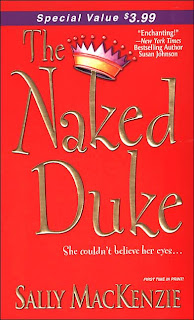Today the Riskies welcome Sally MacKenzie, author of Kensington’s popular “Naked” Regency series. Sally’s The Naked Earl is in bookstores this month. Sally’s books have been praised as having a combination of humor, sensuality, and a hint of suspense. Here is what John Charles of Booklist said of The Naked Earl: “The latest in MacKenzie’s delectably sensual “Naked” historical Regencies series has plenty of sexy sizzle and charming wit.”–John Charles, Booklist
Sally is giving away a copy of The Naked Earl to one of our lucky readers who will be chosen at random Tuesday, April 10 at midnight and announced on the blog. Bertie the Beau has exerted himself to compose official Risky Regency contest rules. Please review them carefully or we will have to endure another Bertie snit!
1. Tell us about your latest book, The Naked Earl.
The Naked Earl is the third book in my Naked series, following The Naked Duke (Feb. ’05) and The Naked Marquis (March ’06). The characters continue and develop, but the books are all stand alone. This book opens with the earl fleeing naked across a portico roof to escape a marriage trap. He climbs through a handy window and into Lady Elizabeth’s bedchamber. Lady Elizabeth, as naked as he, screams–and then decides she’s had enough of being proper. She will be bold and daring just this once–of course, her courage is aided by her earlier overindulgence in ratafia. Various house party intrigues ensue as the earl and Lady Elizabeth–and other guests, as well–make their ways to happily ever after.
2. What, if anything, was “risky” about The Naked Earl?
I feel as if I’m always doing something risky with these books–if nothing else, humor is risky–but probably the most notably risky bit in the Earl is the fact that the hero has what we would call performance anxiety, or, as he puts it, “[h]is shy little organ would not perform in the presence of company.”
3. Tell us about the review of The Naked Earl in Publishers Weekly.
Ooo, how did you know I wanted to talk about that??
The review was definitely a surprise. My agent called on Groundhog Day and asked if I was sitting down. Since we were in contract negotiations at the time, I was rather hoping she was going to tell me the publisher had offered me a six figure deal. Well, a girl can dream, right? But the review was wonderful. I love almost every word. (They did get just a teeny tiny bit wrong.) Here’s the first sentence: “MacKenzie continues her spicy Naked series (following last year’s Naked Marquis) with another ribald Regency, this time centering on a country house party full of the punch-drunk loveless.” It goes on from there and concludes: “Providing plenty of heat and hilarity, MacKenzie has great fun shepherding this boisterous party toward its happy ending; readers will be glad they RSVPed.” Excuse me while I go gaze in rapture at it one more time….
Oh, and while I’m bragging, I’ll tell you that RT gave Lord Westbrooke a KISS. Here’s a quote from their four star review: “MacKenzie continues her delightfully humorous, sexy series with a nice and naughty naked hero who matches wits and wiles with an equally irresistible heroine in the author’s typically touching style.”
 4. All these naked guys in your titles–what a great marketing hook. Did you plan it that way or just how did that come about?
4. All these naked guys in your titles–what a great marketing hook. Did you plan it that way or just how did that come about?
Well, it began as dumb luck, I suppose. One of my friends, a former editor who was critiquing an early draft of my first book, told me my original title was horrible. I had to come up with something better, so I thought, hmm…a title is a marketing tool, so what sells? Sex and power, right? Power = duke; sex = naked, so–The Naked Duke! It fit, since the duke does appear naked in the first chapter. That’s how he’s, um, “dressed” when he meets the heroine, who also happens to be naked.
The Naked Duke provoked a lot of buzz, so when it was time to come up with a title for my second book, sticking with Naked seemed like a good idea. I had two other men, friends of the Duke, to write about. However, I also had a problem–too many earls! Robert Hamilton, the Earl of Westbrooke, played a role in the Duke and had to keep his title. The Earl of Knightsdale, Captain Charles Draysmith’s brother, was only mentioned in passing, so I “promoted” him to a marquis during copy edits for the Duke. Captain Draysmith inherits the title just in time to be The Naked Marquis.
 5. You were one of Kensington’s “Debs.” Tell us about that.
5. You were one of Kensington’s “Debs.” Tell us about that.
In June 2004, Kensington started publishing one book a month by a new author. The books were offered at only $3.99 to encourage readers to take a…risk…on a new writer. (See, I was risky from the beginning!) The stories run the gamut from strict historicals in varying time periods to paranormal historicals to contemporary romantic comedy. An added benefit from my perspective was that the early “Debs” found each other online and bonded. We, and a few other Kensington writers who got their start at the same time, helped each other take our first steps through the publishing maze. We are still friends. You can find us at www.romanceunleashed.com.
6. Why do you write in the Regency era?
I discovered Georgette Heyer at my local library when I was still in grade school and fell in love with her books. I loved the story conventions and the plots, the Regency wit and language. (I even sometimes talk in “Regency-isms.” When I used “brangle” in a conversation, my husband gave me a blank look–that’s how I realized the word is archaic.) And I’m sure it is very un-American of me to say so, but I think there is something very sexy about the aristocracy and landed nobility. I used to wish that I lived during the Regency. Of course, being mostly Irish, I’d probably have been a scullery maid. And really, who wants to live without antibiotics, anesthesia, and modern flush toilets?!!
7. Did you come across anything new or interesting when you were researching The Naked Earl?
I found some interesting objects when I was trying to furnish my dungeon, learned how cue sticks developed in billiards, and stuck my toe into the landscape gardening debate, somewhat of a hot topic in the Regency.
8. Are there more naked guys to come? What’s next for you?
I’ve already handed in The Naked Gentleman, scheduled for May 2008, and I’ve just accepted a contract to write three more books, so I think I’ll be hanging out with Naked guys for a few more years!
Thank you so much for visiting with us, Sally! The Riskies wish The Naked Earl every success and we can hardly wait for the next Naked guy.
Sally will attempt to stop by, so all comments and questions for her are welcome (and will enter you in the contest).









